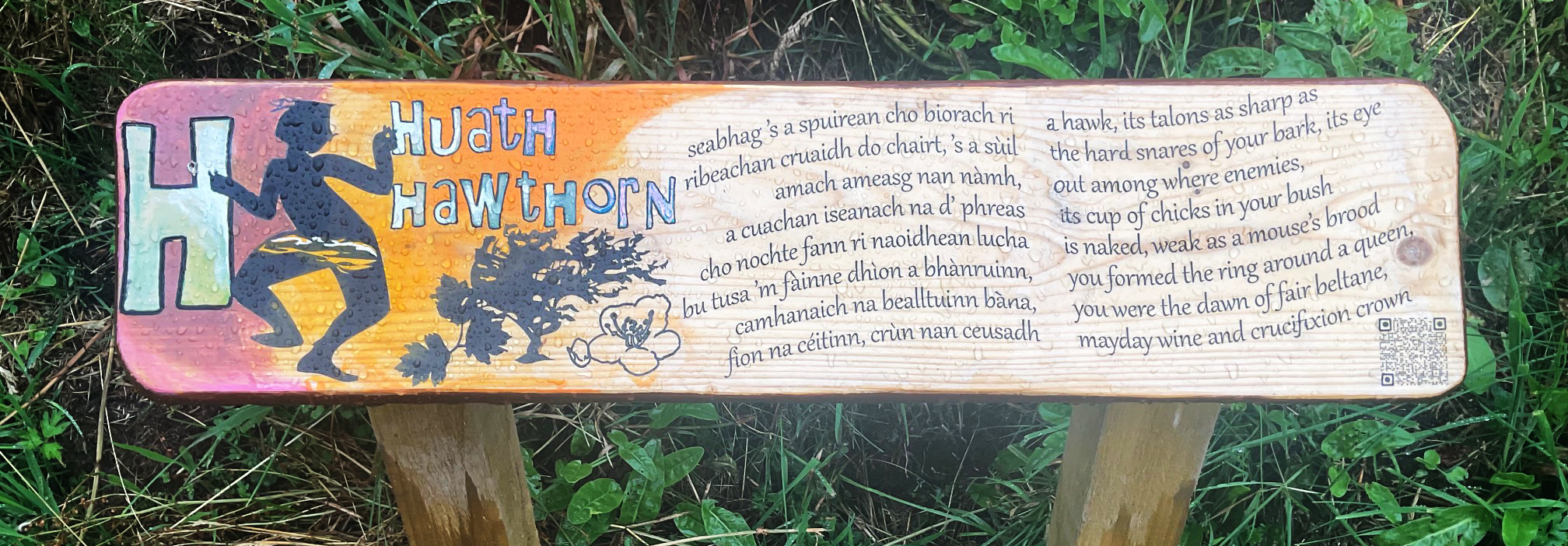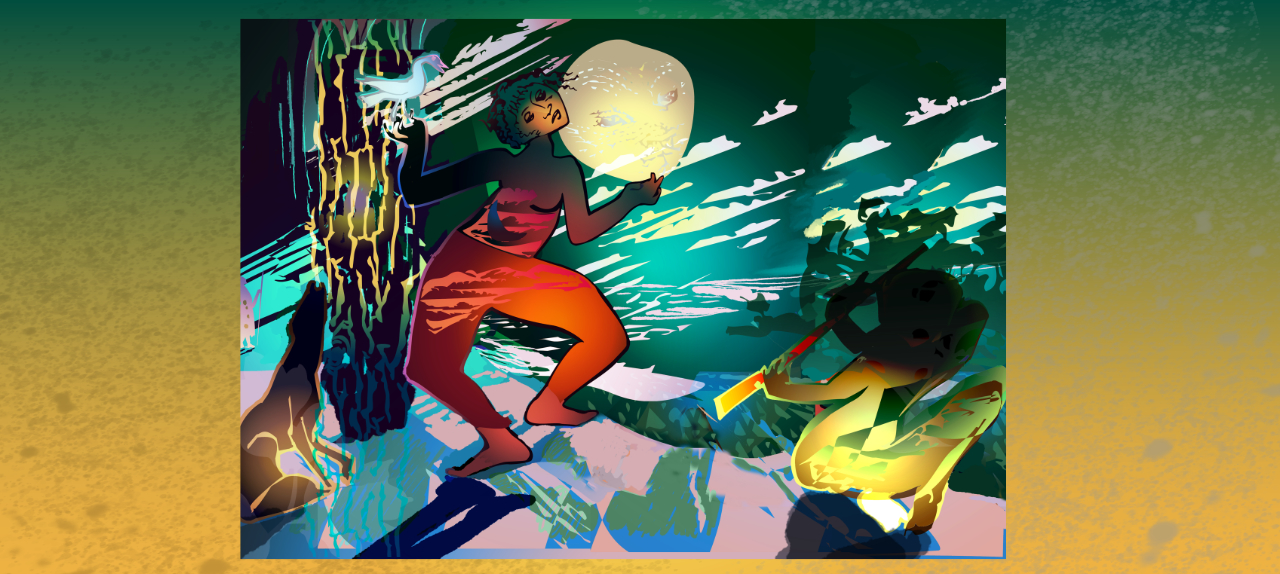
B L N F S H D T C M G P R A O U E I


seabhag ’s a spuirean cho biorach ri
ribeachan cruaidh do chairt, ’s a sùil
amach ameasg nan nàmh,
a cuachan iseanach na d’ phreas
cho nochte fann ri naoidhean lucha
bu tusa ’m fàinne dhìon a bhànruinn,
camhanaich na bealltuinn bàna,
fìon na céitinn, crùn nan ceusadh,
ionad naomh nan òigh ’s nan adhlac,
sporach, slànach, cuimhne thoinnte
eadar reothadh agus toradh,
eadar dubhair geamhraidh’s fàs,
bu tu freiceadan na h-uaisle,
sealgair thaibhse, fasgadh sidhe,
cungaidh cridhe, borb is boidheach
a hawk, its talons as sharp as
the hard snares of your bark, its eye
out among where enemies,
its cup of chicks in your bush
is naked, weak as a mouse’s brood
you formed the ring around a queen,
you were the dawn of fair beltane,
mayday wine and crucifixion crown,
a holy place of virgins, graves,
thorny, healing, plaited memory
between frost and harvest
between winter dark and growth,
guardian of the noble rank,
ghost hunter, fairy shelter,
heart’s balm, fierce and beautiful

Normally a small tree, hawthorn can appear as a multi-stemmed shrub, especially in hedgerows, and is recognised by its distinctive five or three-lobed leaves and short thorns. As a gnarled bush, it can be found often on its own in meadows or at the edge of woodland and in well-lit deciduous woods, it can twist itself into impressive shapes. Its wood is fine-grained and excellent for carving, being often used for inlays on boxes (and even combs). As a firewood it burns very hot.


Very hardy, with deep roots, hawthorn grows well on most soils, although preferably alkaline, where it provides a dense windbreak that prevents passage by animals (its germanic name of hegen, means to protect and nourish). Similar to its cousin, blackthorn, hawthorn has berries that provide food for countless birds and mammals and is home to more than two hundred species of insects, making it a supermarket for nesting birds. With a massive, if often broken, trunk it can live for five hundred years or more, with leaves that appear in mid May and the flowers a week or so after. The strongly scented white blossoms give way toward the end of summer to the brilliant red haws, with each haw (berry) containing a single pit (stone) in the centre.

Thre are many species, not always easy to tell apart. All are thorny shrubs in the Rose family, and most have whitish or pinkish flowers. The leaves when cooked generally taste like lime beans, often chewed when anxious and sometimes used as a tobacco substitute. The flowers are edible and good for salads, while the seeds are sometimes used as a coffee substitute. Medically, hawthorn has been used for generations as a tonic to strengthen the heart and circulation and balance blood pressure. It contains vitamin C and anti-oxidents and can alleviate cramp, general fatigue and indifference and act as relaxant for over-activity. Leaves, flowers or berries can be made into a tea that has few side effects if drunk regularly, and its berries, if dry, are edible if plucked fresh from the bush. Certainly, Neolithic mans diet included hawthorn berries in his diet. Prepared as a jam with other berries or apple, they are excellent, or else used as a chutney.

As herald of summer's imminence, hawthorn has always played the central role. Its other names of May or May Tree gave the month its name, and its white blossoms were used for garlands, wreaths and other decorations, including those of the maypole and particularly at the festival of Beltane (Bel's fire) on May 1st.
Olwen is still celebrated with the white flowers on the crown of the May Queen, but without her 'white track' of flowers - white trefoil - which sprang up from the footprints she made when she walked (see below). Hawthorn's connection to fertility, protection, marriage and betrothal are very ancient and the other herald of spring, the cuckoo, has special affinity with hawthorn in most parts of western Europe.


Its protective charms against evil, witches vampires and lightning meant that most civilisations placed hawthorn twigs above the door to protect the house and stables from harmful spirits. Its key renown, however, lies in its ability to guard springs and wells. In Ireland and Scotland most sacred springs have a hawthorn growing beside them, especially 'clootie wells' , which are decorated with colourful rags, left in return for the blessings of the hawthorn and the sacred spring. However, May or hawthorn is a spirit tree, that has thorns to catch spirits, which is one reason why cloths (or clooties) are hung on it and suggests another meaning to the saying "Ne?er cast a cloot till May is oot". In other European countries the ground and stones beneath them are additionally populated with little statues, lights and other gifts.
In particular, hawthorn is associated very closely with the White Goddess. As Cardea, the roman goddess of childbirth, she represents the good side of the goddess - she protected infants and in Greek myth, Aries and his twin sister, Eris, were born when their mother, Hera, touched hawthorn blossoms. However, another form of the goddess hints at the dark side attached, for she is also Keeper of the Four Winds, who lives 'behind the North Wind' (the North Star, a turning axis) at the door-hinge of the year (see also duir/oak), where she can look both forward and backward in time.


This side is more apparent in other of her names, which include Blodeuwedd ('made of blossom'), Flora and Maia (root of 'May'). As example, in Iceland, hawthorn is called svefnthorn (sleep thorn), and Odin used a hawthorn spine to send Brunhilde into a magical sleep, while in Brittany, Vivaine put Merlin to an enchanted sleep under the hawthorn until his reawakening in another age. These all allude to the origins of the fairy tale of Sleeping Beauty, whose sleep for a hundred years in a castle covered with rose branches, alludes in turn to her original name of Dornroschen (Briar Rose). Hawthorn belongs to the rose family, and the cause of Sleeping Beauty's slumber, pricking her finger on a spindle, has hidden logic, since spindles, together with other small domestic objects such as boxes, tool handles and cabinets, were traditionally made from hawthorn wood. In the Mabinogion, Culhwych, nephew to King Arthur (and whose name means 'pig-run'), has to fulfil thirty-nine (three times thirteen) tasks set by the thunder giant Yspaddaden Pencawr (Giant Hawthorn), in order to marry his beautiful daughter, Olwen, 'She of the White Track'.
As well as reflecting ancient rituals of tasks set for bridegrooms and potential kings, Culhwych's tasks of finding the mystical Thirteen Treasures of Britain not only refer to his initation to kingship and marriage to the goddess, but also to the symbolism of thirteen, representing both the year (of thirteen months) and the resulting 'geis' of such acquired knowledge. For 'geis' is a strict code that has inherent invincibility coupled to binding conditions on those who accept it. Hard won delight is the gift of the May tree. And it is this that helps explain why a taboo existed about bringing it into the house, which by tradition, invited death (ie the giant) and was known as a bad month for marriage. This fine balance of geis is illustrated also in the ballad of Thomas the Rhymer, who, playing his harp by the the Eildon Tree, a hawthorn at Ercildoune, was taken away for seven years by the Queen of Elfland. She gave him his geis, the gift of prophecy, on condition that he never lied, which led to his becoming known as 'True Thomas'. The planetary balance on hawthorn is similarly dual, being described as 'Venus in Aries' by herbalists. Aries is controlled by Mars, so the prickly protective thorns can be seen as the Mars influence, while the influence of Venus is evident in the art, sexuality, beauty and flowers of hawthorn. Her bird is the raven
